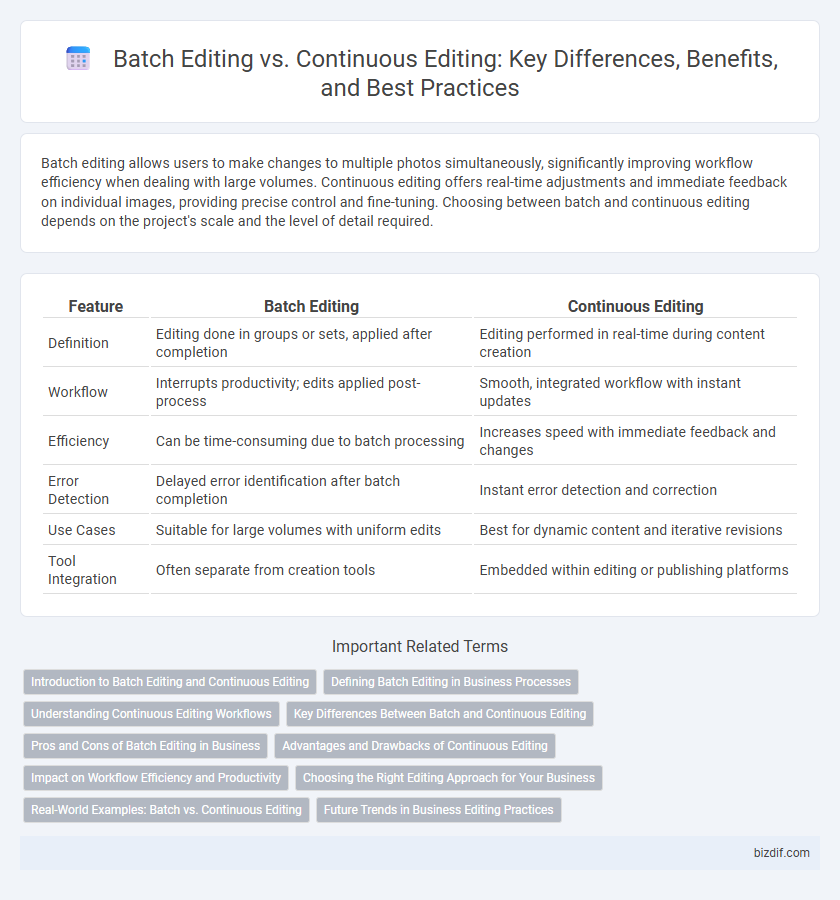Batch editing allows users to make changes to multiple photos simultaneously, significantly improving workflow efficiency when dealing with large volumes. Continuous editing offers real-time adjustments and immediate feedback on individual images, providing precise control and fine-tuning. Choosing between batch and continuous editing depends on the project's scale and the level of detail required.
Table of Comparison
| Feature | Batch Editing | Continuous Editing |
|---|---|---|
| Definition | Editing done in groups or sets, applied after completion | Editing performed in real-time during content creation |
| Workflow | Interrupts productivity; edits applied post-process | Smooth, integrated workflow with instant updates |
| Efficiency | Can be time-consuming due to batch processing | Increases speed with immediate feedback and changes |
| Error Detection | Delayed error identification after batch completion | Instant error detection and correction |
| Use Cases | Suitable for large volumes with uniform edits | Best for dynamic content and iterative revisions |
| Tool Integration | Often separate from creation tools | Embedded within editing or publishing platforms |
Introduction to Batch Editing and Continuous Editing
Batch editing processes multiple files or data sets simultaneously, enhancing efficiency in tasks like photo retouching or video production by applying uniform changes across selected items. Continuous editing involves real-time, incremental adjustments, often used in live broadcasts or dynamic content creation to maintain seamless workflow and immediate feedback. Understanding the differences in workflow, resource allocation, and output timing is essential for selecting the optimal editing approach in various creative and professional projects.
Defining Batch Editing in Business Processes
Batch editing in business processes refers to the systematic modification of multiple documents or data sets simultaneously, enabling efficient handling of repetitive tasks. This method consolidates edits into one session, reducing downtime and minimizing errors through standardized changes. By processing groups of items collectively, batch editing streamlines workflow and enhances productivity in organizational operations.
Understanding Continuous Editing Workflows
Continuous editing workflows enable real-time adjustments, allowing editors to make seamless changes without interrupting the creative process. This approach enhances collaboration by providing immediate feedback and reducing turnaround times compared to traditional batch editing methods. Utilizing software that supports non-linear editing and cloud-based synchronization further optimizes continuous editing efficiency.
Key Differences Between Batch and Continuous Editing
Batch editing processes multiple files or data sets collectively in a single session, maximizing efficiency for large volumes but may delay immediate updates. Continuous editing allows real-time, incremental changes, enhancing flexibility and rapid iteration, crucial for dynamic workflows and live content. Key differences center on processing speed, update immediacy, and suitability for either bulk tasks or ongoing adjustments.
Pros and Cons of Batch Editing in Business
Batch editing in business offers the advantage of processing large volumes of content simultaneously, leading to increased efficiency and consistency across projects. However, it may delay feedback and revisions, as errors can accumulate before being addressed, potentially impacting deadlines. This method is best suited for standardized tasks but less effective for dynamic content requiring real-time adjustments.
Advantages and Drawbacks of Continuous Editing
Continuous editing offers real-time updates and immediate feedback, enhancing efficiency in projects requiring constant revisions and collaborative input. This method minimizes downtime by allowing seamless changes without interrupting the workflow, making it ideal for dynamic environments such as live broadcasting or software development. However, continuous editing may lead to increased errors if changes are made hastily, and it demands robust system resources to manage simultaneous edits effectively.
Impact on Workflow Efficiency and Productivity
Batch editing consolidates similar tasks, enabling focused bursts of work that reduce context switching and enhance overall workflow efficiency. Continuous editing allows real-time adjustments, promoting immediate feedback and iterative improvements, which can boost productivity in dynamic projects. Choosing between batch and continuous editing depends on project complexity, deadlines, and the need for flexibility in the editing process.
Choosing the Right Editing Approach for Your Business
Batch editing streamlines workflow by grouping similar tasks for efficiency, ideal for projects with uniform content and tight deadlines. Continuous editing offers real-time adjustments, enhancing flexibility and responsiveness, making it suitable for dynamic content environments. Selecting the right approach depends on your business needs, project scope, and desired turnaround times to maximize productivity and quality.
Real-World Examples: Batch vs. Continuous Editing
Batch editing involves processing large sets of photos or videos in groups, ideal for event photographers who edit entire wedding galleries at once to maintain consistency. Continuous editing suits newsrooms and live broadcasters where content is edited in real-time to ensure immediate publishing and timely updates. Software like Adobe Lightroom supports batch editing with presets, while systems like Avid Media Composer enable continuous editing workflows for live events and breaking news coverage.
Future Trends in Business Editing Practices
Batch editing remains prevalent in business workflows due to its efficiency in handling large volumes of content simultaneously, yet continuous editing is gaining traction with real-time collaboration technologies. Advances in AI-powered editing tools are expected to enhance continuous editing by providing instant feedback and error detection, streamlining the revision process. Future trends emphasize integrating cloud-based platforms and machine learning algorithms to optimize both batch and continuous editing workflows, improving accuracy and turnaround times.
Batch Editing vs Continuous Editing Infographic

 bizdif.com
bizdif.com